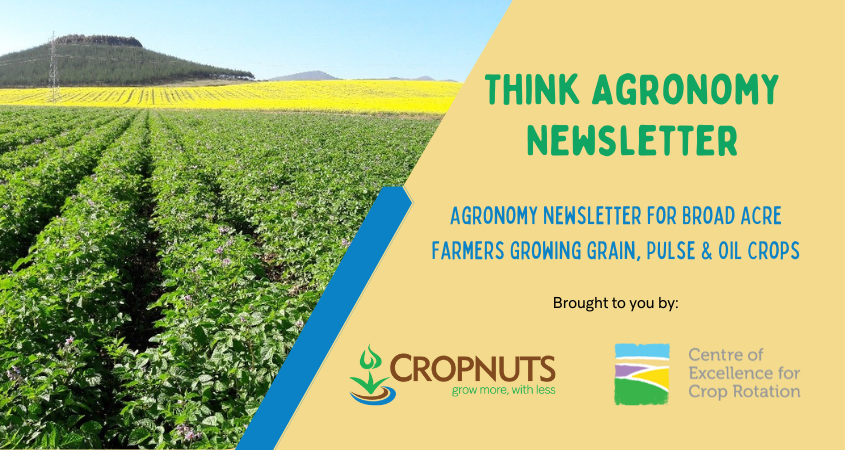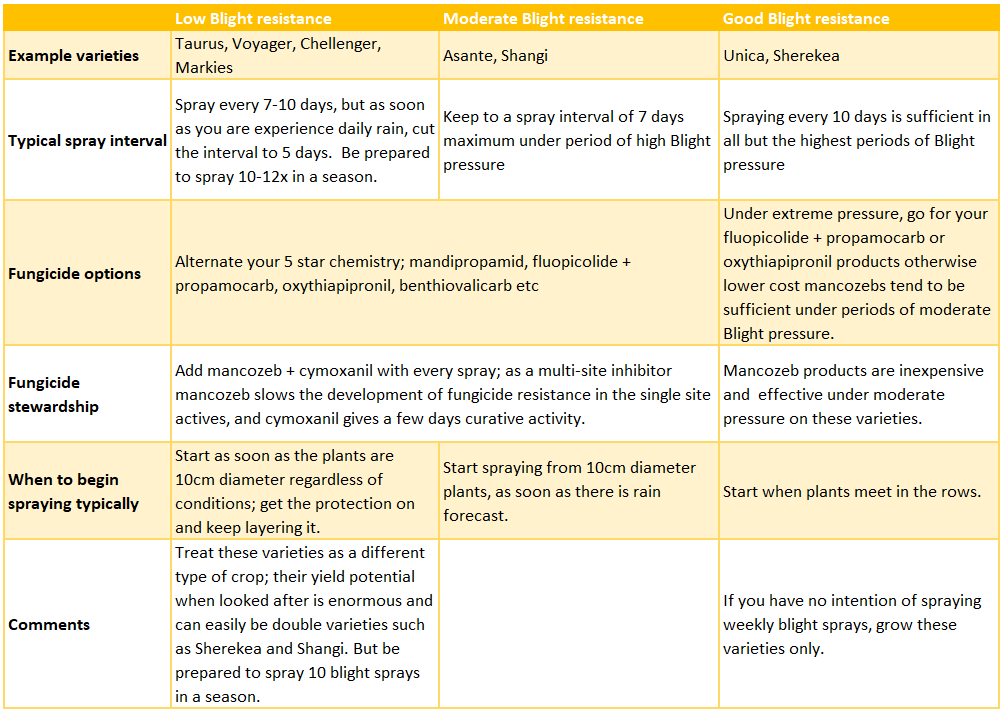
As we approach the potato planting season, good planning is essential to achieve the best from the crop and maximise your profits. We take a look at the steps to consider:
Number 1 is certified seed; you do not need the crop to be held back by diseases such as Blackleg, Black Dot, and Rhizoctonia and certainly do not need to introduce Potato Cyst Nematode (PCN) to your shamba. Severe Black Leg and PCN can halve yields, so buying KEPHIS Certified Seed is a must.
Length of rotation – keep a minimum of 5 years between potatoes, ideally longer. If there is any disease or PCN building up this will allow for a period of decline, allowing you to grow the crop sustainably – and for our children to grow it in the future too. There is always a debate as to whether 5 crops can constitute a sufficient break in areas where double cropping is possible; essentially not in the case of PCN as the decline pattern in the soil does not appear to be influenced by the frequency of other crops. So to be absolutely sure, 5 years gap between potatoes means 5 years!
Soil structure – Behind good quality seed, preparing a well-structured seedbed is probably the next most important requirement for potatoes to thrive. Cultivations need to remove compaction and loosen the soil to 30cm, but they do not need to be overly fine; a level of 5 -10cm clods in the ridge is essential to prevent slumping and help stabilise the soil. Always dig a soil pit to visually look at what you are dealing with before even starting to cultivate.

Potato seed varieties
Seed rates depend on seed size and row spacing and there are plenty of online calculators to help work out the seed spacing. As a general rule, for 90cm rows, you will be planting 30,000 – 45,000 seeds per hectare (12-18,000 per acre), which depending on the seed size could range from 2 to 4 tons/ha. Remember that varieties with fewer stems per tuber tend to benefit from higher seed rates; so Shangi and Taurus would be at the higher end of this range, Sherekea is less responsive to higher seed rates.
Once planted, weed control becomes the next priority to avoid yield loss. Pre-emergence options include pendimethalin, linuron, metolachlor, clomazone, and metribuzin (where varieties and local legislation allow). Pick the herbicides to match the spectrum of weeds on your farm; for Cleavers, clomazone is essential. For Nightshade and brassica weeds, linuron really helps. Remember that you have in-crop chemistry for grasses only; fluazifop, clethodim and propaquizafop are all excellent for controlling Brome and Setaria, but for Ryegrass clethodim is essential.
Do a soil test and use some science as to what fertilisers you apply, remembering that potatoes are very responsive to Phosphate. Be wary of being sucked in by fancy multi-mix trace element mixes that promise the earth. A leaf test by a reputable soil testing lab will reveal what is happening in the crop, and can save you thousands of Shillings in unnecessary chemicals.
One of the best tools I have found in recent years is a Deep Available Nitrogen test to help adjust topdressing – if it is even needed. Some of the french fry varieties such as Markies and Panamera require very little nitrogen relative to others; push too hard with topdressing and you will struggle to get good skin set to lift and transport them safely.

As maize emerges from the ground in good conditions across the country, so begins the scouting for Fall Armyworm. Since 2017 this pest has traumatised farmers, but as well as declining in its severity since it first appeared – in most farms I visit – some very obvious trends have emerged.
Firstly, Fall Armyworm is undoubtedly far worse in continuous maize. From spraying 5-6 times with some quite undesirable insecticides in 2017 and 18, we are now typically spraying 2-3 times and seeing far less damage at the end of the crop. Talking to many smaller farmers growing continuous maize, however, they are still often spraying 4-5 times and their crops still have significant visible damage.
This is unlikely to be a direct result of moths or pupae surviving in maize residues as it is well known that Fall Armyworm does not diapause; so the adult moths hatch fairly quickly after pupating and have to lay their eggs on another host grass species. It is far more likely to be that continuous maize crops are less healthy and unable to defend themselves from insect attack. We simply don’t know this for certain but it is so obvious in the field.

Seed dressing with cyantraniliprole proved to be very effective on Cutworms last year and the Fall Armyworm activity is also well recognised, however in trials that I set up, the insect pressure was simply not high enough to be able to see any difference! Perhaps this year will be a sterner test.
If and when you do have to spray, the active ingredients which keep showing good efficacy on the larvae are indoxacarb, emamectin-benzoate, acephate, pyriproxifen, and chlorantraniliprole.
Reviewing thresholds in other parts of the world for Fall Armyworm is very revealing; 75% or more plants infested, with larvae less than 3cm in length (any larger and insecticides won’t control them), or 25% of corn whorls with two or more larvae. I suspect that this is a far higher level of damage than we often tolerate before reaching for the insecticide…
I am increasingly using grain nutrient testing as a tool for checking the success of fertiliser programs. The benefits are obvious; a bulk sample can be taken easily from the entire crop (a soil sample represents a mix of perhaps only 20 points in a field), is very quick, and gives a statement of what actually made it into the crop at the point which matters – harvest (a leaf test is a very useful snapshot of the status of the plant at a moment in time, but it changes rapidly through the season).

Grain P% at harvest clearly corresponds closely to yield, as we saw in a recent Agventure trial in Timau. There is some noise in the data but the trend is obvious; under-apply P and it will show up when you measure the grain.
A grain nutrient test report gives you the actual level of 13 nutrients; there is a high level of confidence in some of these to indicate whether the crop may have been deficient. Luckily for us, there has been a lot of work into phosphorus levels in grain and it has shown to be a very good indicator of whether P supply to the crop was adequate.
The critical threshold seems to be 0.32%; below this and you need to examine whether sufficient P was applied to the crop. There is no mathematical equation to tell you whether you are right however; using grain nutrient in conjunction with soil testing and leaf analysis simply provides you with more points of reference.

Sulphur, manganese, and copper are three other elements for which there is a high degree of confidence in the levels being able to help predict deficiency. I suspect that we need to do a bit more work on copper in our environment, but as I said in the last newsletter we rarely see sulphur responses in trials, and the grain nutrient samples I have done confirm that the crops appear well supplied.
As an aside, grain P testing has shed some scepticism on the standard P removal figures that we often rely on. What has blown my mind over the past month however is how a World Record Spring Barley yield of 11.0 T/ha was achieved – here in Kenya – with a grain P level of only 0.20%! Have we under-applied the phosphate and left even more potential in the field, or do these guidelines break down at extreme yield levels?!
Till next time,
David Jones
Independent Agronomist
Think Agronomy is brought to you by Cropnuts and the Centre of Excellence for Crop Rotation. We share the same vision for sustainable, dryland farming across Africa, and Think Agronomy is our independent voice to promote profitable, climate-resilient farming through better management of soil health, systems-based agronomy, crop diversification, and farm mechanization.
How would you rate this article? Click link

David is an independent agronomist in Kenya and a member of the Association of Independent Crop Consultants. David gives independent advice based on scientific trials and experience. Currently works with the Centre of Excellence for Crop Rotation. Follow him on Twitter @Kenya_agron
Order our services and get to know how to improve your soil for better yeilds.